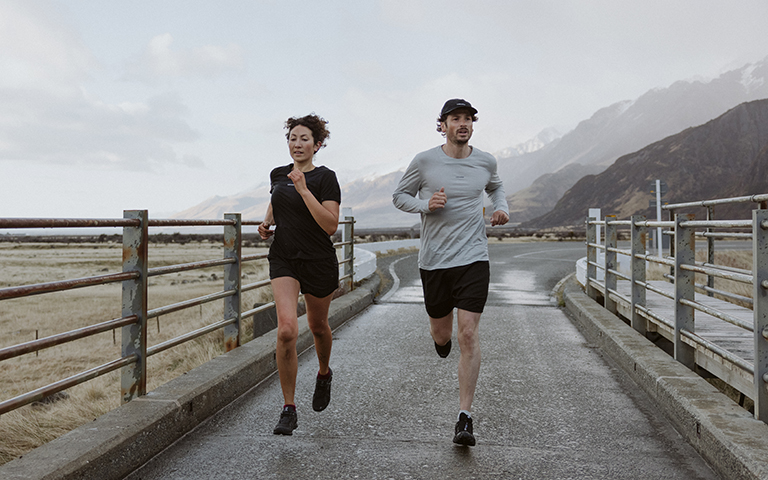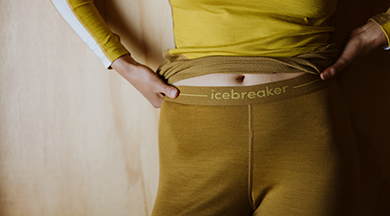Hiking Gear Essentials
18 May 2023
Hiking is one of the best activities to enjoy the outdoors, escape the day-to-day, and get some fun exercise. Whether you’re on your first or the hundredth adventure, a hike through nature is always breathtaking and refreshing. But it takes another level of skill to trek through woods, mud, rocks, sand, and more – and still look fresh and fabulous.
Most outdoors enthusiasts focus on practicality and comfort when selecting their hiking outfit, but you don’t have to choose between the natural aesthetic you love and the quality you need. This icebreaker guide can help you pick the perfect hiking outfit for you!
Hiking gear: the basics
There’s no shortage of outdoor gear available today from icebreaker and the like, and in a range of styles for various needs: from the easy, comfortable solution for the first-timer hiker to the advanced, technical tools for the multi-month adventurer. No matter your skill level or trail type, the basic needs of everyone are the same. It all comes down to your comfort to determine what works for you.
Essential hiking gear checklist
Typical, everyday fabrics like denim and cotton are heavy and absorb sweat, making them uncomfortable quickly. Fibres like merino wool and exclusive icebreaker technology Cool-Lite ™ can help your body regulate its temperature and protect you from the elements. These are moisture-wicking and breathable, allowing your body to sweat without the moisture getting stuck on your skin and causing issues.
Many of these fabrics are also waterproof and have a variety of coatings and treatments to help you through any climate. At icebreaker, we’re proud of our several innovative fibres that keep you cool and comfortable while you conquer the great outdoors.
Strong but lightweight materials are usable without being a burden and can hold their own against the environment. Even if you’re embarking on a short, half-day excursion, you’ll still need to carry essential equipment and tools with you – and you don’t want to deal with the heavy, improper gear. There’s a range of materials designed for the outdoor world, from carbon fibre to silicon, each designed with the hiker in mind.
Essential hiking gear checklist
The first step in packing for your hike is your backpack. You should opt for a backpack rather than a crossbody satchel or messenger bag so your hands can be free and your gear is appropriately distributed and accessible.
For a day hike, you can use a backpack with a capacity of 15-30 litres, depending on how much you’d like to bring with you. Your backpack should have plenty of interior, exterior, and hip pockets; external clips and/or straps; chest and waist straps to distribute the pack’s weight; and a pocket for hydration packs.
Some items seem obvious, like water and protein-dense snacks, but other items may not be necessary for a smaller hike and can be easily forgotten. It’s important to remember that nature is unpredictable and never to be underestimated; hopefully, you won’t need to use items like a first aid kit or fire starter on a mere day hike, but you should always have them in case of emergencies. Even if your worst experience is slipping and getting a cut on your knee, you’ll be happy to have a band-aid.
These are icebreaker's top 10 items that must be on your hiking gear checklist:
- Water
- First aid kit
- Protective outer layers
- Navigation
- Headlamp
- Extra layers
- Sun protection
- Nutritional snacks
- Knife or multi-tool
- Firestarter
- Gear repair tape
For a multi-day journey or more challenging terrain, modify these gear recommendations accordingly: a larger backpack, camping gear, and more food and water.
Essential hiking outfit checklist
Be dressed to meet mother nature head-on. This means layers, even on sunny, warm trails. You never know when the weather might turn or if your trail takes you through different microclimates, such as low valleys or high mountains, where the air is significantly cooler than when you started. icebreaker has a range of different options for clothing layers to choose from as well which will ensure you are never caught lacking. It’s better to pack some extra layers and not need them than to need protection and not have it.
Follow this icebreaker checklist for your hiking outfit:
- Breathable underwear
- Insulating mid layers
- Protective outer layers
- Hat and/or sunglasses
- Thick socks
- Sturdy shoes with tread
- Hiking pants
- Gloves
- Rain jacket
Hiking outfits for women
In most cases, men- and women-designed clothing depends on the fit. Women’s clothing is typically designed for smaller, curvier figures, shorter legs, and either a less muscular body or a difference in muscle distribution. The hiking outfit essentials, however, do not change regardless of type.
Underwear and base layer
These layers should be materials that breathe well and wick moisture. Think workout clothing – yoga leggings are an excellent choice for the casual hiker. The material can handle sweat and long periods of movement without chafing, bunching, or becoming heavy. icebreaker’s merino wool underwear and bras are made of innovative fabric that stays soft, breathable, and odour-free. icebreaker’s base layers, too, are designed to fit your body and stay comfortable throughout your activity.
Mid layers
Your mid layers are arguably the most versatile and personalised since they depend largely on the environment and the hiker’s comfort. The main purpose of mid layers is to insulate, helping your body regulate its temperature as exercise heats it and sweat cools it..
In a warmer area, you could wear a single mid layer of just a short-sleeved shirt or a light hoodie, while in a cooler environment, you may wear multiple mid layers of long-sleeved shirts, vests, or jumpers. Women’s mid layers should still be fairly form-fitting and fit over the hips so that there are no gaps between your shirt and trousers where the elements could slip through..
Outer layers
The outer layers should protect you against the elements: rain, snow, wind, and sun. For a warm-weather trip, your outer layer can be a lightweight, long-sleeve shirt to provide skin protection without overheating. In colder environments, your outer layer should be a lightweight, waterproof, windproof, and potentially insulating jacket.
The outer layer should be a sturdy material that can shield your skin from scraping against rocks or vegetation. While many hikers opt for a single pair of hiking leggings or hiking trousers, in the cold, you may want a layer of leggings and an outer layer of trousers. Ensure your outer layer fits loosely enough to comfortably fit your layers beneath but is still fitted enough to keep your insulation – and not hinder your motions with too long sleeves or too baggy pant legs.
Hiking outfits for men
Men’s hiking clothing is typically designed for taller and bulkier frames: longer and broader torsos, longer legs, and a narrower waist and hips than women. Similar to women, it’s important that men’s hiking outfits fit their bodies, with no excessive bunching or gaps between articles.
Underwear and base layer
Men’s underwear and base layers should be made of breathable, quick-drying fabrics such as merino wool. Many hikers recommend well-fitted underwear styles like briefs or hiking tights, which can be more comfortable for long periods of activity, but ultimately, it is up to you and your preference. Again, the base layer should keep moisture off your skin and help expel it.
Mid layers
Men’s mid layers should be made of insulating fibres like an icebreaker Merino wool long-sleeve sweatshirt. A zippered jumper or light long-sleeve shirt is a versatile mid layer that can work well for microclimates. However, opt for more specific mid-layer items if you’re trekking through a significantly warmer or colder environment, such as the desert versus the mountains.
In warmer areas, a t-shirt or light jumper is suitable; in colder climates, make sure to prepare well with warm but breathable jumpers and long sleeves. Make sure your mid layer clothing fits well to your body and doesn’t leave too much space between layers or at your neck, wrists, or hemline.
Outer layers
Protective outer layers should be lightweight and sturdy, able to fend off wind, rain, and rough patches that could tear your softer under layers or your skin. In warmer regions, your outer layer should be a light rain jacket or sun shirt to protect you without making your body too warm.
In colder environments, your outer layer should be a thicker material that conserves your body heat and stops cold air or water from getting inside. You might also want to add lighter or heavier hiking trousers on top of your bottom layer. A hooded jacket is useful as it provides even more protection. While your outer layer should be loose enough to fit your layers underneath and still allow a full range of motion, make sure it’s not too loose.
Now that you’re well informed, even if you are a veteran or simply planning your first journey, icebreaker is here to make sure you have all the essentials you could need. So take a look at icebreaker’s entire range of hiking gear and equip yourself for your next adventure.
More for you

Merino socks for hiking | icebreaker
26 August 2020 | Marie Knowles

The Tech Behind ZoneKnit™ | icebreaker
16 September | Jamie Patterson

Washing Merino Wool Clothes | Does Merino Shrink?
28 September 2020 | Marie Knowles
More for you









